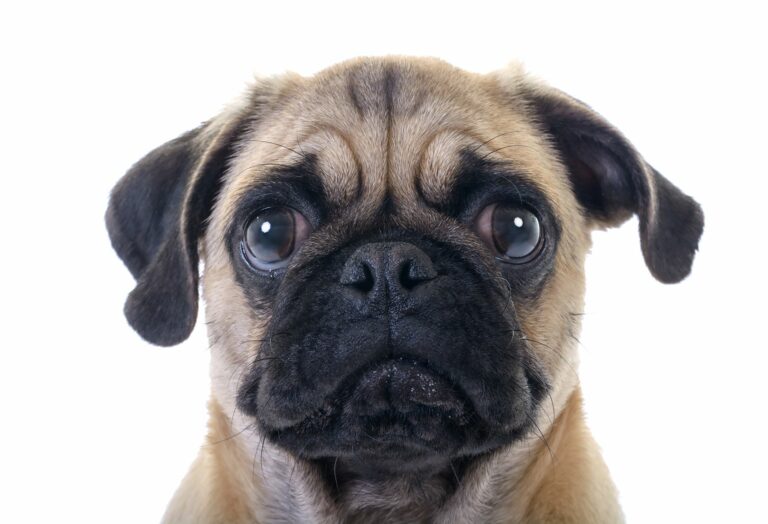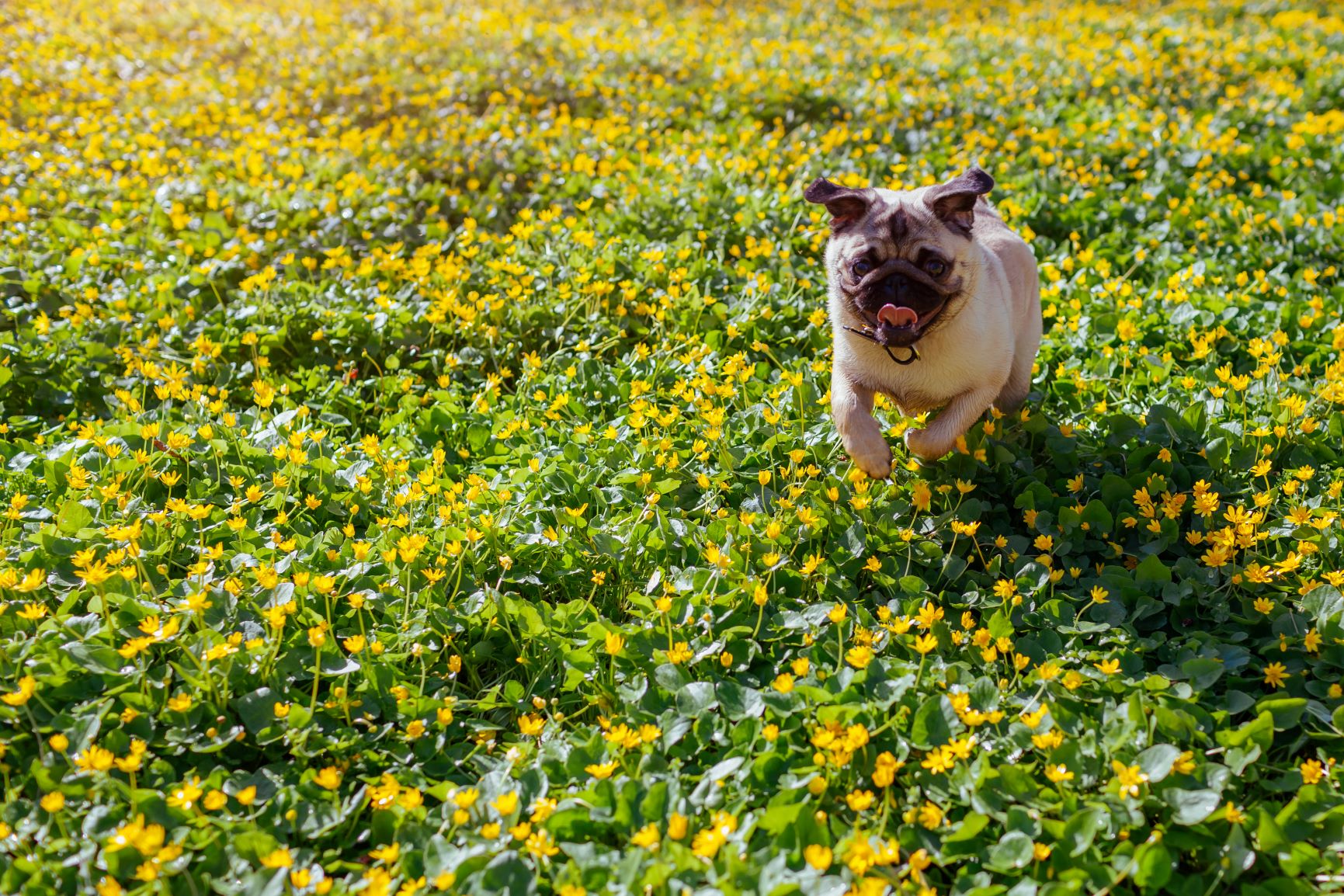Beagle
The Beagle's short legs can be deceiving – this medium-sized dog keeps you on your toes and is always full of surprises! This friendly breed is active, fearless and extremely clever.
Everyone knows Pugs – but what about Retro Pugs? What sounds like a cool trend has a serious, ambitious backstory, because Retro Pugs represent the attempt to give Pugs, popular society dogs, better health and quality of life.

© MilsiArt / stock.adobe.com
The Retro Pug is sportier and less extreme in its appearance than the normal Pug.
A Retro Pug looks like a Pug – or more precisely, like a Pug from the 1950s or 1960s, because Pug breeding has gone in an unhealthy direction since then. Nowadays, Pugs are associated with unhealthy breeding due to their squished airways and stocky build.
The Retro Pug is based on the following standard:
Overall, Retro Pugs appear sportier, more mobile and less extreme than what many people nowadays recognise as Pugs. Normal rather than bulging eyes, no skin folds to maintain, a nose that allows them to breathe – all these physical differences aim to improve quality of life.
The Retro Pug is an intelligent dog that is happy to form a close bond to its human family and work together with them. In a reputable breed, the nature of Retro Pugs is slightly different from that of normal Pugs.
Be they Retro or not, Pugs are straightforward companion dogs. Retro Pugs enjoy exercise more than their relatives with barely-there snouts. They adapt well to day-to-day life with their human family, hardly bark and are friendly to humans and animals – provided that they are well socialised.
With consistency, motivation and a bit of patience, training a Retro Pug is no problem, because these dogs like working together with their owner.
However, you cannot expect military discipline – their personality is too independent for this. If a Pug isn’t keen, it simply has no inclination, although you can teach it good basic obedience.
The Retro Pug may have a light hunting instinct, because its ancestors can include the Parson Russell Terrier or Beagle.
Grooming a Retro Pug isn’t very challenging for owners. The short, smooth fur doesn’t get matted, but you should still brush your dog every few days or use a rubber massage glove. This allows you to collect many excess hairs that would otherwise be spread throughout your home. The Retro Pug tends to moult.
Unlike Pug relatives with extremely crumpled faces, Retro Pugs should only have minimal face wrinkles. These are much easier to maintain and the risk of infections in the folds of skin is minimised. The eyes are also less sensitive, but you should regularly clean the lop ears.
This new-old Pug variety is very well suited to families. It likes children, but you should never leave small children unsupervised with a Pug. Since Retro Pugs are also somewhat fitter than their heavy-breathing fellow Pugs, they are good excursion companions. Pensioners who enjoy spending time outdoors with their dog can also be happy with a Retro Pug.
Since Retro Pugs are open and friendly, they generally get on well with cats. Dogs that have had bad experiences with cats can be an exception.
Read our article on cat and dog cohabitation.
Be it city or countryside – the main thing is being in a pack. Pugs are happy anywhere their owner is. These dogs are also suitable for people who can take their dog to work with them.
If you’ve ever seen a Pug bred to extremes on a normal walk, you will know that just walking wears this breed out. Sporting activities are therefore impossible.
Things are better with Retro Pugs, but they are no sporting aces. You can cover a few kilometres with them at a comfortable pace every day, but they are also satisfied with less exercise.
Agility or high-motion sports like flyball aren’t suitable for Retro Pugs, but retrieval at their pace, tug and intelligence games are great for wearing them out. Some Retro Pugs also enjoy little tricks, such as with clicker training, and search games.
Although the Retro Pug is indicative a dog breed in which health is valued, this unfortunately isn’t a matter of course with all providers. By now, resourceful imitators have come up with the idea of selling Retro Pugs that are merely Pug hybrids. Retro Pug breeders do pair other breeds, but in a controlled manner and with the objective of increasing the proportion of the Pug breed in future generations.

“The head is round so that thoughts can change direction.”
Most of the Pug’s health problems come from its round head – time to change something! Retro Pug breeders focus on the exact points that make Pugs a torture breed in the eyes of many animal lovers, because they consider health one of the most important breeding objectives.
Hereditary diseases to be investigated
This is a long list. Genetic tests are particularly important at the start of breeding. If the parents are free of ailments, corresponding proof in the family tree is often sufficient. Retro Pug breeding is on solid ground thanks to thorough selection. Although breeders give a lot of importance to a longer snout, this can result in brachycephalia and therewith breathing difficulties with Retro Pugs.
Some dogs tend to suffer from excess weight – a predisposition that is more common amongst normal Pugs. Make sure portions are needs-based. Choose a high-quality dry food instead of fatty snacks for training and adapt daily portions accordingly.
A healthy Retro Pug can reach 15 years of age or more.
The name Retro Pug reflects the breeding ideology of breeders going back to the Pug’s origins. However, this is subject to criticism too.
The Pug presumably comes from the Chinese Empire, where it was bred for the nobility. At the start of the modern era, it came to the Netherlands and from there it conquered the salons of many rich ladies all across Europe. Interest grew at the beginning of the 20th century. Around 100 years later, the Pug became a fashion dog.
Unfortunately the original appearance has given way to extremes: the eyes literally bulge out of the small, wrinkled head. The respiratory tract suffers beneath the flat snout. Many nowadays consider the Pug in this form to be torture breeding. Breeding bans have already taken place in the Netherlands. Hence, reputable breeders are endeavouring to find new methods, which is where the Retro Pug enters the picture…
Retro Pug breeders have abandoned the standards of Pug breeding. They don’t exhibit their dogs and pair other breeds – prohibited in FCI pug breeding. Critics accuse Retro breeders of breeding hybrids. With cross-breeding, however, reputable Retro Pug fans are specifically following the plan back to the 100% Pug of around 60 years ago.
Unlike with hybrids or designer dogs, they specifically pair subsequent generations with one another in order to create a uniform phenotype. Nevertheless, Retro Pug breeding remains a controversial subject amongst Pug fans.
So you love pugs but don’t want to support the breeding of animals suffering from respiratory problems? A good idea – and not just Retro Pug breeders can make this wish come true.
Breeding programmes supported by the FCI are an alternative. Breeders don’t pair any other breeds, but solely choose Pugs with a lower level of brachycephalia that have an FCI pedigree. However, these Pugs are not yet available for purchase.
Old German Pugs are another possibility. These are also pedigree Pugs that have been specifically paired with one another based on the old example.
Attention: Unscrupulous breeders focused on quantity over quality often advertise using the term Old German Pug even if it is a hybrid! The same applies for Pugpuggles and the Puggle designer dog, its origin. Alternative breeds are the Boston Terrier and French Bulldog.
Tip: there are many Pugs and similar dogs in animal shelters waiting for a new home.
There is no question that Retro Pugs are very nice little dogs. However, breeding is still controversial amongst dog lovers, so do a lot of research before making a purchase. Resourceful breeders focused on quantity over quality smell the chance to earn a quick buck when they call Pug mixes ‘Retro’. Nevertheless, having a Pug in which the animal’s health and wellbeing are the top priority is certainly a good idea.
The Beagle's short legs can be deceiving – this medium-sized dog keeps you on your toes and is always full of surprises! This friendly breed is active, fearless and extremely clever.
The Golden Retriever is still one of the most popular dog breeds, especially with families. It is defined not just by its docility, but shows numerous other qualities too. Read in the following article everything you need to know about the Golden Retriever.
The German Shepherd is one of the most popular utility dog breeds in the world, though the willing-to-learn and people-focused nature of these versatile dogs also makes them suitable for family life.